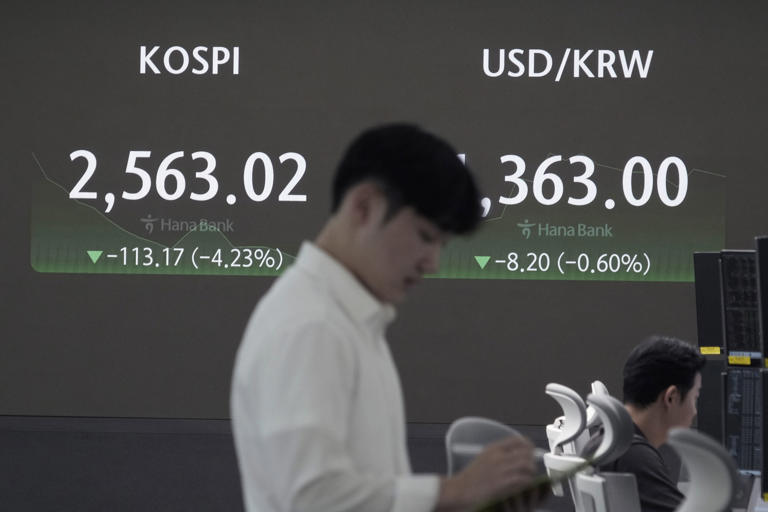Japan’s benchmark Nikkei 225 stock index experienced a significant downturn early Monday, plunging as much as 8.1% at its lowest point. This steep decline follows a period of global market turbulence that began last week, driven by mounting concerns over the state of the U.S. economy. The Nikkei’s fall represents a dramatic shift from recent highs, reflecting broader anxiety about economic stability both in Japan and worldwide.
The Nikkei 225, which had surged to unprecedented heights of over 42,000 in recent months due to a surge in investor enthusiasm, saw its value drop dramatically, shedding over 2,900 points to settle at 32,991.88. The market’s broader TOPIX index mirrored this sharp decline, falling 8% as the sell-off gained momentum through the afternoon. This latest downturn marks a severe contrast to the index’s prior peak performance and indicates a significant correction in the market.
The sell-off is partly attributed to a recent report showing that U.S. employment growth had slowed much more than anticipated. This weaker-than-expected jobs report has caused widespread concern among investors, shaking the confidence that had previously driven markets to new highs. Additionally, Japan’s financial markets have been impacted by recent changes in the Bank of Japan’s (BOJ) monetary policy. On Wednesday, the BOJ raised its benchmark interest rate, a move aimed at addressing the prolonged weakness of the Japanese yen, which had led to inflation surpassing the central bank’s 2% target. As of Monday morning, the yen was trading at 143.07 per dollar, a significant drop from its late Friday value of 146.45 and well below its levels of over 160 yen per dollar observed just a few weeks ago.
The impact of these developments extends beyond Japan. In South Korea, the Kospi index experienced a sharp decline of 6.5%, with shares of technology giant Samsung Electronics falling by 7.7%. Similarly, Taiwan’s Taiex index plummeted 7.4%, driven by a significant drop in shares of Taiwan Semiconductor Manufacturing Co., the world’s largest chip maker, which saw an 8% decline.
The global sell-offs have also influenced other markets. Early Monday trading saw the VIX index, which measures investor fear and anticipated volatility for the S&P 500, fall by about 26%. This decline indicates a shift in sentiment as investors grapple with the evolving economic outlook. Bitcoin, which had recently surged to nearly $70,000, saw a dramatic 14% drop, settling at $54,155. This drop reflects broader uncertainty in the financial markets, impacting both traditional and digital asset classes.
Oil prices remained relatively stable amidst the market turbulence. U.S. benchmark crude oil rose slightly by 9 cents to $73.61 per barrel, while Brent crude was unchanged at $76.81 per barrel. The stability in oil prices contrasts with the broader volatility in financial markets, highlighting the complex dynamics influencing different asset classes.
The sell-offs come in the wake of a significant report indicating weaker-than-expected job growth in the U.S., which has heightened fears of an economic slowdown. The U.S. stock markets had recently experienced a surge in optimism following Federal Reserve Chair Jerome Powell’s indication that inflation might be under control enough to warrant potential interest rate cuts. However, the recent market decline suggests that investor confidence in a smooth economic transition may be wavering.
Investor sentiment is further complicated by the uncertainty surrounding future Federal Reserve policies. While there is speculation that the Fed might begin reducing interest rates in September, the timing and impact of such a policy shift remain uncertain. A reduction in rates could potentially stimulate economic activity by making borrowing cheaper, but the benefits of such a move may take several months to materialize fully.
In Asia, other markets also showed signs of stress. Hong Kong’s Hang Seng index fell by 0.2%, while the S&P/ASX 200 in Australia dropped by 12.8%. In contrast, the Shanghai Composite index, somewhat insulated from global market fluctuations by capital controls, managed to edge up by 0.1%.
The recent market volatility has pushed the Nasdaq composite down 10% from its recent record high, marking what traders refer to as a “correction.” This downturn comes shortly after the Nasdaq experienced its best day in months, spurred by optimism surrounding potential rate cuts. However, the subsequent market corrections have highlighted the ongoing uncertainties and risks facing investors.
Tan Boon Heng of Mizuho Bank in Singapore emphasized the growing concerns about a potential recession, noting that high unemployment could constrain consumer spending and further impact economic activity. This scenario reflects broader anxieties about the U.S. economy’s ability to maintain its growth amidst high interest rates and evolving global market conditions.
